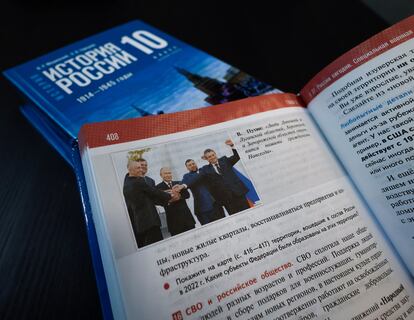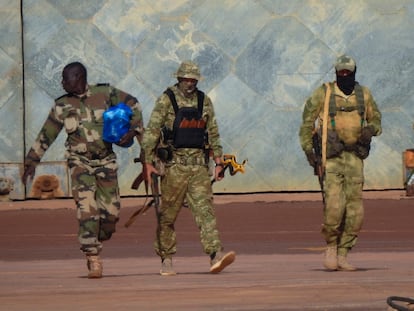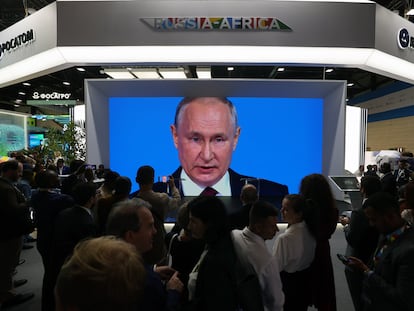Russian students to be schooled in a version of history tailored to Vladimir Putin’s nationalism
A new textbook to be introduced as compulsory reading in high schools rewrites much of post-World War II history to meet the designs of the Kremlin

Russian students have a new textbook on the official history of their country, tailor-made to suit Vladimir Putin’s nationalist policies. Compulsory reading for students in the final year of secondary education, the textbook will come into use in Russian schools starting next September. It will be the only text permitted and rewrites a large part of world history from 1945 to the present day.
Putin, who usually offers his own interpretation of history to justify his policies, had repeatedly expressed his desire to introduce a single history textbook “with a single concept” and based on the Kremlin’s “official assessment,” in order to put an end to diversity. “Dispersion leads to negative consequences, to young people not understanding what country they live in and not feeling their connections to the heroes of the past,” the Russian president said in 2013.
The textbook is already circulating in its full version on the internet. As the backbone of the entire period, “the West” appears as a malevolent and envious environment that perpetrated and rejoiced in the misfortunes of the USSR, including the collapse of the Soviet state. “Over the Kremlin the state flag of the Soviet Union was lowered. The leading countries of the West reacted with undisguised approval to the self-liquidation of the USSR,” notes the account of the final moments of the USSR on December 25, 1991.
This assessment of hostility is repeated even when positive rapprochements between Moscow and the West are acknowledged, such as the détente of the 1970s and the Helsinki Final Act of 1975, which kick-started the process of disarmament and reduction of regional tensions between the U.S. and the USSR of the 1980s. The text, however, states that Western policies would have continued in the same vein during the presidency of Boris Yeltsin in the 1990s and to the present day, in the form of support for separatism and financial investments designed to gain access to Russian technology.
The official authors of the textbook are Vladimir Medinsky — former Minister of Culture and an advisor to Putin, and Anatoly Torkunov — rector of Moscow’s State Institute of International Relations. Across its 448 pages, the book alternates between pride over events valued as successes (access to nuclear weapons, increase in military power, industrial development) and victimhood over the attitude of the West.
The text includes the ongoing war unleashed by Putin in Ukraine, which is designated by its official description as a “Special Military Operation.” “The most important event in contemporary history is the incorporation, or more accurately, the return, of our historical lands to the Russian Federation,” it notes.
In search of arguments to prove that Ukraine is part of Russia, the manual delves into centuries of history and foreign territories. Among its illustrations is an official 2023 map of Russia, which has capriciously extended its borders to all Ukrainian lands annexed since 2014, including those it does not even control on the ground. At the end of the text is a gallery of a dozen heroes decorated during the war, starting with the first Russian soldier to receive a medal (posthumously), and four female participants in the conflict.
“Russia is a country of heroes [...] Courage and readiness to give one’s life for the motherland were and are inherent throughout the centuries” says the text, while also offering topical advice to students. “Such unique times do not occur often in history. After the departure of foreign companies there are many open markets before you [...] and fantastic possibilities for a career in business and in start-ups themselves are open. Do not miss this opportunity. Russia today is really the country of opportunities.”
The animosity of the book’s authors toward Mikhail Gorbachev, the final leader of the Soviet Union, is clear from the foreword. “The policy of perestroika, begun under the leadership of Mikhail Gorbachev (1985-1991) and hasty reforms led to growing chaos in the economy and in the social field and to the destruction of the state,” the text states. The “architect of perestroika” had “no clear plan of action,” and “was misguided in the problems of industry, the army, the military-industrial complex, and had little understanding of foreign policy issues. [Gorbachev] never worked in production, he did not direct a construction site, he was not the director of a large factory, nor did he have the experience of a ministerial job,” the text notes. “Out of the Cold War only one superpower emerged, the USA. The other, the USSR, was destroyed,” it concludes.

Reverence for Stalin
Unlike Gorbachev, the figure of Joseph Stalin is treated with respect. The repression he unleashed is compensated by the greatness of the tasks he undertook in the view of the textbook, which approaches the tragedies that unfolded under his regime with broad strokes. The book does not venture into Stalin’s concrete relationship with the repression, but considers it important enough to mention that in 1949 his 70th birthday celebrations “were attended by many foreign leaders, among them the leader of China, Mao Tse-Tung.”
Not included in the book are the suffering of the peoples of the North Caucasus (which are not even mentioned) and of the Crimean Tatars, who during World War II were accused of collaborating with the German occupiers and deported to Central Asia in cattle cars under harsh conditions. Their lives, it is merely noted, “were very hard, although the local authorities made every effort to provide them with food and facilitate their daily lives.” Among Communism’s successes, the manual notes the development of refrigerator production during the 1950s and 1960s.
Historians and intellectuals differ as to the effect this ideologized view of history will have on Russian adults of the future. Some believe they will be victims of the current indoctrination while others suspect that it will be forgotten, as were the ideological teachings of the Soviet school system, where there was also a single history textbook “but much more professionalism,” according to historian Vladimir Dolin. “The works of real historians will reach children and students if they have real teachers. And the fake ones will fill children’s heads with dust and chaff with any textbook,” he notes. “The misfortune is that this textbook is the only one [that will be used], and this would not be so serious if there was not total control of teachers in today’s schools.” Reports have been circulating of teachers being forced out of work or expelled for attending pacifist and anti-war demonstrations. Sometimes these teachers are denounced by their own students, or their parents.

“The greatest geopolitical disaster of the 20th century”
In the section dedicated to the disintegration of the USSR, “the greatest geopolitical tragedy of the 20th century,” there is no mention that the Soviet Constitution gave the federated republics the right to leave the USSR and the meeting of the Slavic leaders who dissolved the Soviet Union in a hunting lodge in Belarus on December 8, 1991, is dispatched with six lines. Neither does it say that the new states formally (and more than once) undertook to recognize the borders in place when they were federated republics within the same country.
The work suffers from the reversal of cause-and-effect relationships. Thus, the deployment of Soviet troops in Afghanistan is justified as a result of the Islamist presence and NATO’s interventionist intentions. The Atlantic Alliance had nothing to do with Afghanistan and the alleged reason for the Soviet invasion was to aid local pro-Soviet leaders at loggerheads with each other.
The information transparency promoted by Gorbachev is also considered a failure because, when all the limitations of censorship had been eliminated and the state was practically inhibited from controlling the media, the citizens of the USSR were inundated with destructive and hostile information presented as “freedom of expression” to a society that relied on the written word.
The departure of Soviet troops from Europe after 1989 is judged as “a very thoughtless decision” that undermined Soviet influence and “fostered the emergence of nationalist and anti-Soviet sentiment.” The handbook refers to the so-called “velvet revolutions” that took place in Eastern Europe between 1989 and 1990 and to the “annexation of the German Democratic Republic by the Federal Republic of Germany.” The issue of German reunification is dismissed with the phrase “the GDR was swallowed up by the FRG” and the leaders of the Western countries are accused of not keeping their “verbal promises not to expand NATO to the East.” None of the objectives laid out under perestroika were fulfilled, except the destruction of the Soviet state, notes the new history textbook.
Sign up for our weekly newsletter to get more English-language news coverage from EL PAÍS USA Edition
Tu suscripción se está usando en otro dispositivo
¿Quieres añadir otro usuario a tu suscripción?
Si continúas leyendo en este dispositivo, no se podrá leer en el otro.
FlechaTu suscripción se está usando en otro dispositivo y solo puedes acceder a EL PAÍS desde un dispositivo a la vez.
Si quieres compartir tu cuenta, cambia tu suscripción a la modalidad Premium, así podrás añadir otro usuario. Cada uno accederá con su propia cuenta de email, lo que os permitirá personalizar vuestra experiencia en EL PAÍS.
¿Tienes una suscripción de empresa? Accede aquí para contratar más cuentas.
En el caso de no saber quién está usando tu cuenta, te recomendamos cambiar tu contraseña aquí.
Si decides continuar compartiendo tu cuenta, este mensaje se mostrará en tu dispositivo y en el de la otra persona que está usando tu cuenta de forma indefinida, afectando a tu experiencia de lectura. Puedes consultar aquí los términos y condiciones de la suscripción digital.
More information
Archived In
Últimas noticias
There is as much life left to discover on planet Earth as that which is already known
Dozens presumed dead, around 100 injured in fire at Swiss Alps bar during New Year’s celebration
Is porn for women different from conventional porn? We spoke to those who make it
Cartagena de Indias is sinking: What can the city do to mitigate it?
Most viewed
- Reinhard Genzel, Nobel laureate in physics: ‘One-minute videos will never give you the truth’
- David King, chemist: ‘There are scientists studying how to cool the planet; nobody should stop these experiments from happening’
- Oona Chaplin: ‘I told James Cameron that I was living in a treehouse and starting a permaculture project with a friend’
- Sinaloa Cartel war is taking its toll on Los Chapitos
- The Interoceanic Train, the Mexican alternative to the Panama Canal











































